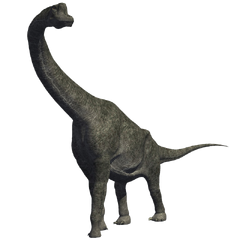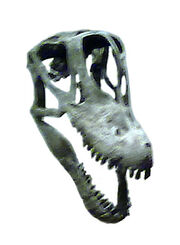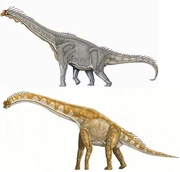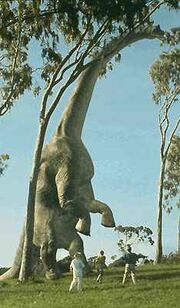| Brachiosaurus Temporal range: Late Jurassic | |
|---|---|

| |
| A restoration of Brachiosaurus altithorax | |
| Scientific classification | |
| Kingdom: | Animalia |
| Phylum: | Chordata |
| clade: | †Neosauropoda |
| Order: | †Saurischia |
| Suborder: | †Sauropodomorpha |
| Family: | †Brachiosauridae |
| Genus: | †Brachiosaurus Riggs, 1903 |
| Species: | †B. altithorax
†B. Indicus |
| Binomial name | |
| Brachiosaurus altithorax Riggs, 1903 | |
Brachiosaurus altithorax (meaning "arm lizard") is a large genus of small skull (about the size of a common horse skull), long muscular tail, and thin columnar limbs. As with other Brachiosauridae, it was over 40 feet tall. It was a herbivore.
History of discovery[]
Holotype specimen[]

Mounted skeleton of Giraffatitan.
The genus Brachiosaurus is based on a partial postcranial skeleton discovered in 1900 in the valley of the Colorado River near Fruita, Colorado.
Genus Brachiosaurus, and Chicago. In 1899 Riggs had sent inquiries to rural locations in the western United States concerning fossil finds, and Bradbury, an amateur collector himself, reported that dinosaur bones had been collected in the area since 1885. It was Riggs' field assistant H. W. Menke who found the skeleton on July 4, 1900.
Additional Brachiosaurus fossils are reported on Riggs Hill, but other fossil finds on the hill have been vandalized. Riggs published a short report in 1901, noting the unusual length of the humerus compared to the femur and the extreme overall size and the resulting giraffe-like proportions, as well as the lesser development of the tail, but did not publish a name for the new dinosaur. The titles of Riggs (1901) and (1903) suggested that the specimen was the largest known dinosaur.

The Felch Quarry skull (Garden Park Brachiosaur)
Riggs followed his 1903 publication that named Brachiosaurus altithorax with a more detailed description in a monograph in 1904. The Fruita skeleton was not the first discovery of Brachiosaurus bones, although it was the first to be recognized as belonging to a new and distinct animal.
In 1883, a sauropod skull was found near Garden Park, Colorado, at Felch Quarry 1, and was sent to Othniel Charles Marsh. Marsh incorporated the skull into his skeletal restoration of "Brontosaurus" (now Apatosaurus). It eventually became part of the collections of the National Museum of Natural History.
eevaluated the Garden Park skull as more similar to Camarasaurus. It was described and recognized as a Brachiosaurus skull in 1998 by Kenneth Carpenter and Virginia Tidwell, intermediate in form between Camarasaurus and Giraffatitan brancai (then still considered to be Brachiosaurus brancai). Because there are no overlapping parts between this skull and the discovered in 1900, it cannot be confidently assigned to a species, so it is classified as Brachiosaurus.

B.Altithorax(up) and Giraffatitan(down) comparison
Additional discoveries of Brachiosaurus material in North America have been uncommon and consist of a handful of bones. Material has been described from Colorado, Oklahoma, Utah, and Wyoming, and undescribed material has been mentioned from several other sites.
The Giraffatitan material(from Tengaduru in 1914) was considerated firstly as B. altithorax, but describing the "brachiosaurid" material, Janensch listed a number of differences and commonalities between them and B. altithorax. In three further publications in 1929, 1950 and 1961 Janensch compared the two species in more detail, listing 13 putative shared characters. Of these, however, only four appear to be valid, while six pertain to more inclusive groups than Brachiosauridae, and the rest are either difficult to assess or refer to material that is not Brachiosaurus.
In 1988, Gregory Paul published a new reconstruction of the skeleton of "B." brancai, highlighting a number of differences in proportion between it and B. altithorax. Chief among them is a difference in the way the trunk vertebrae vary: they are fairly uniform in B. altithorax, but vary widely in the African material. Paul believed that the limb and girdle elements of both species were very similar, and therefore suggested to separate them not at genus, but only at subgenus level. Giraffatitan was raised to genus level by Olshevsky without comment.
A detailed study of all material, including the limb and girdle bones, by Michael Taylor in 2009 found that there are significant differences between Brachiosaurus altithorax and the Tendaguru material in all elements known from both species. Taylor found 26 distinct osteological (bone-based) characters, a larger difference than that between, for example, Diplodocus and Barosaurus, and therefore argued that the African material should be placed in its own genus, Giraffatitan, as G. brancai. An important difference between the two genera is the overall body shape, with Brachiosaurus having a 23% longer dorsal (trunk) vertebrate series and a 20 to 25% longer and also taller tail.
Paleoecology[]
With the removal of the East African Giraffatitan, Brachiosaurus is known only from the Morrison Formation of western North America. The Morrison Formation is interpreted as a semiarid environment with distinct wet and dry seasons, and flat floodplains. Vegetation varied from gallery forests (river–lining forests in otherwise treeless settings) of conifers, tree ferns, and ferns, to fern savannas with rare Araucaria-like trees. Several other sauropod genera were present in the Morrison Formation, with differing body proportions and feeding adaptations. Among these were Apatosaurus, Barosaurus, Camarasaurus, Diplodocus, Haplocanthosaurus, and Supersaurus. Brachiosaurus was one of the less abundant Morrison Formation sauropods, due to its relatively large size, and extensive need for fresh greenery and water. It's thought although if you lived during the Jurassic, you might as well see a herd of these wander by. Brachiosaurus fossils are found only in the lower-middle part of the expansive Morrison Formation (stratigraphic zones 2-4), dated to about 154-153 million years ago, unlike many other types of sauropod which have been found throughout the formation.
Description[]
Size[]
Most estimates of Brachiosaurus altithorax's size are based on the related brachiosaurid Giraffatitan (formerly known as B. brancai), which is known from much more complete material than Brachiosaurus. But fossil remains of even larger Brachiosaurus is 158 metric tons in weight, at stood 20–22 meters (66–72 ft) tall and was 30 meters (98 feet) long.
Paleobiology[]
In contrast to most other sauropods, Brachiosaurs had an inclined back, due to their long forelimbs. Therefore, if the neck exited the body in a straight line, it already pointed upwards. The exact angle is influenced by how the pectoral girdle is reconstructed, that is how the shoulder blades are placed on the ribcage. The mobility of the neck was reconstructed as quite low by Stevens and Parrish, while other researchers like Paul and Christian and Dzemski argued for more flexible necks, it is quite unsure if the neck of the Brachiosaurus was stiff, or flexible.
Brachiosaurus is thought to have been a high browser, feeding on foliage well above the ground. Even if it did not hold its neck near vertical, and instead had a straighter neck, its head height may still have been over 9 metres (30 feet) above the ground. It probably fed mostly on foliage above 5 metres (16 feet). This does not preclude the possibility that it also fed lower at times, between 3 to 5 metres (9.8 to 16 feet) up.
Its diet likely consisted of ginkgos, conifers, tree ferns, and large cycads, with intake estimated at 200 to 400 kilograms (440 to 880 lbs) of plant matter daily. However, more recent studies estimate that ~240 kilograms (530 lbs) of plant matter would have been sufficient to feed a 70 metric tons (77 short tons) sauropod, so Brachiosaurus may have required only about 120 kilograms (260 lbs) of fodder a day.
Brachiosaur feeding involved simple up–and–down jaw motion. The teeth were arranged to shear material as they closed, and were probably used to scrape vegetation into the mouth to be swallowed directly without chewing. .

Jurassic Park showing a highly speculative; raised InGEN-Brachiosaurus
It has repeatedly been suggested, for example, in the movie Jurassic Park, that Brachiosaurus could rear into a bipedal or tripodal (with tail support) pose to feed. However, a detailed physical modelling-based analysis of sauropod rearing capabilities by Heinrich Mallison showed that while many sauropods could rear, the unusual brachiosaurid body shape and limb length ratio made them exceptionally ill suited for rearing. The forward position of the center of mass would have led to problems with stability, and required unreasonably large forces in the hips to obtain an upright posture. Brachiosaurus would also have gained relatively little from rearing (only 33% more feeding height), compared to other sauropods, for which a bipedal pose may have tripled the feeding height.
Like all sauropods, Brachiosaurus was homeothermic (maintaining a stable internal temperature) and endothermic (controlling body temperature through internal means), meaning that it was able to actively control its body temperature, producing the necessary heat through a high basic metabolic rate of its cells. In the past, Brachiosaurus has been used an example of a dinosaur for which endothermy is unlikely, because of the combination of great size (leading to overheating) and great caloric needs to fuel endothermy. However, these calculations were based on incorrect assumptions about the available cooling surfaces (the large air sacs were not known), and a grossly inflated body mass. These inaccuracies resulted in overestimation of heat production and underestimation of heat loss. The large nasal arch has been postulated as an adaptation for cooling the brain, as a surface for evaporative cooling of the blood. Again, when this was proposed, cooling via the air sacs was not known, and thus not taken into account. Furthermore, other similar sized sauropods had no comparable structure. Additionally, in proportion to the entire animal, the nasal arch is very small, and would thus have made only an insignificant contribution to heat loss.
The nostrils of rhe Brachiosaurus (like other sauropods, for example the Giraffatitan), the huge corresponding nasal openings in its skull, were long thought to be located on the top of the head. In past decades, scientists theorized that the animal used its nostrils like a snorkel, spending most of its time submerged in water in order to support its great mass. The current consensus view, however, is that the Brachiosaurus was a fully terrestrial animal. Studies have demonstrated that water pressure would have prevented the animal from breathing effectively while submerged and that its feet were too narrow for efficient aquatic use. Furthermore, new studies by Lawrence Witmer (2001) show that, while the nasal openings in the skull were placed high above the eyes, the nostrils would still have been close to the tip of the snout (a study which also lends support to the idea that the tall "crests" of brachiosaurs supported some sort of fleshy resonating chamber).
In The Media[]
- Because of its size and unique appearance, Brachiosaurus has been portrayed in several types of media movies, Including Disney's Fantasia, the blockbuster movies Jurassic Park, Jurassic Park 3 & Jurassic World: Fallen Kingdom, Paula is a baby Brachiosaurus from 3 Prehisteria Films, A bunch are seen in couple Ice Age Films, Disney’s Dinosaur as Baylene & in some of The Land Before Time Movies.
- They even appeared in some Documentaries like a few are seen in the documentary series Walking with Dinosaurs, Episode 2, Time of the Titans & Allosaurus: A Walking with Dinosaurs special. Especially a couple animated ones like 1 was seen in The Dinosaurs “The Nature of the Beast” & A whole Herd of Green colored Brachiosaurs was Walking around probably heading towards their nesting site from “Dinosaurs on earth, then ... and now” by the National Geographic Society. It also appears in Dino Dan, Dino Dan: Trek’s Adventures & Dino Dana as a Rare/Common Character.
- Brachiosaurus products are almost as common as Tyrannosaurus and Triceratops products, with a large line of toys and other collectibles. In The Land Before Time X:The Great Longneck Migration, a young green Brachiosaurus named Shorty.
- Brachiosaurus appears in Fossil Fighters as a vivosaur.
- Brachiosaurus appears in the game Jurassic World Alive, as an Epic-class dinosaur, which can be unlockable by darting 150 Brachiosaurus DNA. It's a key recipe in the gigantic superhybrid, Ardentismaxima.
- Brachiosaurus appeared on Dinosaur Train
- Brachiosaurus also appears in the 2011 Sci Show: Terra Nova, where it appeared as a docile herbivore.
- Brachiosaurus is another dinosaur that makes a debut in the sandbox game, Jurassic World Evolution. It can be dug in several North American digsites.
- Brachiosaurus is the alt-mode for a Dinobot called Slog in the Transformers Franchise. An actual Brachiosaur also appears at the beginning of AOE.
- Brachiosaurus made an appearance in the ROBLOX game called "Dinosaur Simulator."
- Brachiosaurus is one of the early-access animals in the game Prehistoric Kingdom
References[]
- https://www.livescience.com/25024-brachiosaurus.html
- https://www.nhm.ac.uk/discover/dino-directory/brachiosaurus.html
- https://kids.nationalgeographic.com/animals/prehistoric/facts/brachiosaurus
- https://www.britannica.com/animal/brachiosaur
- https://nature.ca/notebooks/english/brachios.htm
- https://www.thoughtco.com/things-to-know-brachiosaurus-1093776































